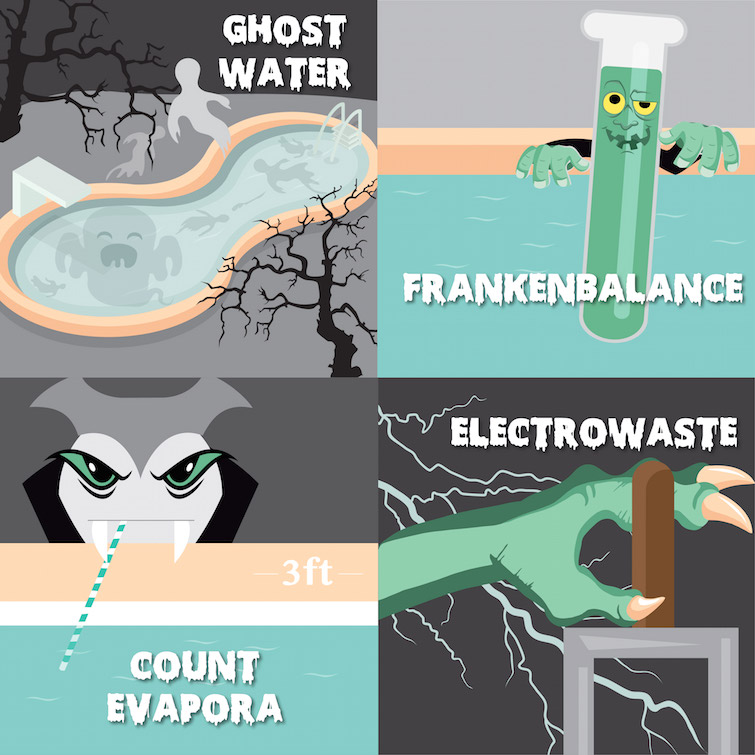How to Handle Top Swimming Pool Issues
October 19, 2016 at 11:21 PM

Regular pool maintenance keeps your investment in pristine, working condition, but every so often, you may encounter an issue with your pool. The good news is most of these issues are fairly common and easily fixed. Read on for most typical pool issues.
1. Cloudy water. Your pool looks a little milky, not the crystal-clean water you expect. A lot of factors can contribute to the look: pool chemistry, filtration, algae, even shade from a tree that creates a shadow over the pool. First, you’ll want to diagnose why it’s not clear. Check your filter to make sure it’s operating properly and is on at least 8-10 hours a day. Test your pool chemicals to make sure there’s enough chlorine sanitizing the water and that your pH levels are balanced. These, in turn, control algae growth and other bacteria that forms in the pool when chlorine is low.
Once you’ve determined the culprit, it’s time to reverse the cloudiness. Balance your pH and ensure there’s enough chlorine. Check your filter to determine if it needs backwashing or replacement, and then after performing any necessary backwashing replacement, run it overnight until the water is clear. It also helps to give your pool walls and floor a good scrubbing and vacuuming before filtering. Shock the pool if your free chlorine levels are low. If none of this is clearing up your pool, try adding a pool clarifier, or flocculent. Run your filter until the water is clear. You’ll also want to vacuum your pool after to remove the particles drawn up by the flocculent. Calling a pool technician for expert help is also a good way to go, so you don’t miss any steps.
2. Water balance. Unbalanced water is often the cause behind many pool issues, among them cloudiness. When the pH level is incorrect, it can cause the above-mentioned cloudy water, calcium deposit build-up, skin and eye irritation, and other water health issues.
pH levels are measured on a scale where 7 is neutral, and anything below 7 is acidic and anything above is alkaline. A swimming pool should be about 7.2-7.8. It’s important to test your water daily to make sure it stays within that range. Anything can alter the pH, from rain and debris to human sweat.
3. Skin irritations. Water that’s below ideal can cause a lot of discomfort to a swimmer’s skin and eyes, which can curb the level of enjoyment you receive from a swimming pool. Fortunately, it’s not difficult to locate the source of the problem.
Test your pool’s total alkalinity, pH and chemicals. pH levels that are low indicate acidity, which can cause a burning sensation. Then, check that the proper amount of chlorine has been added to the pool. While too-low levels can cause bacteria and harmful microorganisms to grow, a too-high level can also irritate the skin. Bring your levels to that recommended by the manufacturer or your pool technician.
4. Energy conservation. Pools require energy to run pumps, filters, heaters, lighting, and more. However, there are a lot of ways to lower your energy bills and be environmentally-friendly. For example, select a pool heater that is suitable to your needs. If you plan to swim frequently and live in a warmer climate, trading in a traditional gas heater for a heat pump may be more energy and cost-efficient in the long run. A heat pump takes the available heat in the ambient air and transfers it directly to the pool water, while a traditional gas heater requires gas to heat up and uses a lot of energy to heat the pool quickly.
Lights, too, come in a range of energy-efficient varieties, including the popular long-lasting LED lights. LED bulbs do not emit heat and last for nearly 30,000 hours. And pool pumps can also be energy-efficient and offer variable speeds so you don’t have to use excess energy when unnecessary.
If you’ve forgotten to turn off your heater, lights, or left the pool cover on, and you’re not home, you can also operate all of this from a smartphone app. The app syncs with your control systems, allowing you to heat up the pool before coming home, or turning it and your lights off if you’re away.
5. Water loss. Pools lose water due to evaporation, use, splashing, and cleaning. Extra evaporation can usually be avoided by adding a pool cover when the pool is not in use, which also maintains the pool’s warm temperature.
[READ: Pool Covers and Water Conservation]
If, however, you have to re-fill your pool about two inches each week, chances there’s a leak of some kind. Even though pools are built to be carefully sealed and watertight, wear and tear will start to cause some of those sealants to separate.
First, inspect your filter system to see if it leaks only when it’s on. If it’s leaking all the time, check if there’s a crack in the plaster, if the plastic skimmer has separated from the concrete shell, or if there’s separation around the pool accessories, such as underwater lights. Also note if there are wet spots around the pool and near the equipment pad.
When all else fails, call a leak expert, since it’s easy to miss a potential reason behind a leak. Most leaks are fairly simple to repair, as long as they are not ignored and are fixed sooner than later.
Overall, the most common pool issues are easy to fix or recognizable enough to identify and to correct right away. It’s a good idea to consult with your swimming pool technician to avoid these issues in the first place or to have them examined and fixed before they become more complex problems.